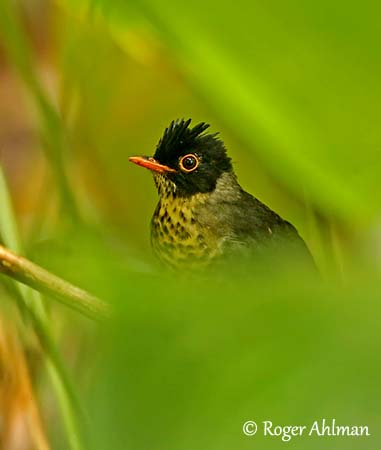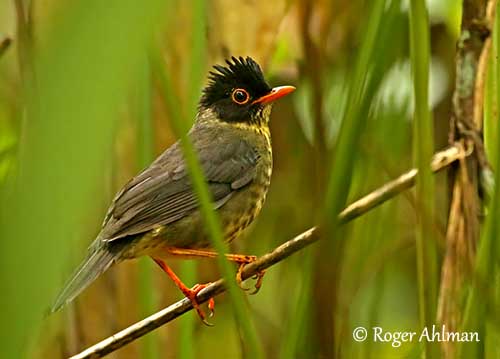
Fr: Grive tavelée
Ang: Spotted Nightingale-Thrush
All: Tropfenbrust-Musendrossel
Esp: Zorzalito Overo - Zorzal Pecho Amarillo
Ita: Tordo usignolo maculato
Nd: Gevlekte Dwerglijster
Sd: Gulbröstad skogstrast
Photographer:
Roger Ahlman
Pbase Galleries Peru and Ecuador
Text by Nicole Bouglouan
Sources:
HANDBOOK OF THE BIRDS OF THE WORLD Vol 10 by Josep del Hoyo-Andrew Elliott-David Christie - Lynx Edicions - ISBN: 8487334725
A GUIDE TO THE BIRDS OF MEXICO AND NORTHERN CENTRAL AMERICA by Steve N. G. Howell, Sophie Webb - Oxford University Press - ISBN: 0198540124
A GUIDE TO THE BIRDS OF COLOMBIA by Steven L. Hilty and William L. Brown - Princeton University Press – ISBN 069108372X
THRUSHES by Peter Clement and Ren Hathway – HELM - ISBN: 0713639407
BirdLife International (BirdLife International)
Academia.edu - Especies. Revista sobre conservación y biodiversidad
iBytes – Conocer la Tierra abre la mente
Neotropical Birds – Cornell Lab of Ornithology
Spotted Nightingale-Thrush
Catharus dryas
Passeriformes Order – Turdidae Family
INTRODUCTION:
The Spotted Nightingale-Thrush is included in the subfamily Turdinae (typical thrushes) in the large family Turdidae. The genus Catharus includes rather small, spot-breasted thrushes of America, S to the northern Andes.
The Spotted Nightingale-Thrush is a shy bird found in the undergrowth of humid montane forests in the highlands of southern Central America and the Andes to NW Argentina.
This species could be threatened by habitat loss in a near future.
DESCRIPTION OF THE BIRD:
Biometrics:
Length: 17-19 cm
Weight: 36-44 g
The adult of nominate race has dull olive-grey upperparts, including wings and tail. The black head and the olive-grey mantle are separated by indistinct dull yellowish collar.
On the underparts, chin and throat are buff and finely streaked grey, whereas the area from lower throat and neck sides to belly is pale yellow spotted dark grey. Lower belly, vent and undertail-coverts are whitish. The flanks are greyish.
The head is black. The bill is red-orange. The eyes are dark brown, surrounded by narrow red-orange eyering. Legs and feet are bright orange.

The female is similar but she has greyer head and more olive back. The bill has darker culmen.
The juvenile has dark olive-brown upperparts streaked pale buff. The dark head is streaked with brown. The underparts are dark olive with fine, pale yellowish-buff mottling.
SUBSPECIES AND RANGE:
Six subspecies are currently recognized.
C.d. dryas (here described) occurs in W Guatemala to Honduras and W Ecuador.
C.d. harrisoni occurs in the highlands of SE Mexico (Oaxaca).
C.d. ovandensis occurs in the highlands of S Mexico (Chiapas).
C.d. maculatus is found on the E slope of the Andes of Colombia to E Ecuador, E Peru and N Bolivia.
C.d. ecuadoreanus occurs in the Andes of Ecuador.
C.d. blakei is found in the Andes of extreme N Argentina.
These races differ on bill, legs and eyering colour (more or less red), more or less olive upperparts and variation of yellow on the underparts.
HABITAT:
The Spotted Nightingale-Thrush is usually found in the cloud forest, in damp ravines and along forested streams. This species occurs between 1200 and 3000 metres of elevation. It forages in the undergrowth of the humid montane forests.
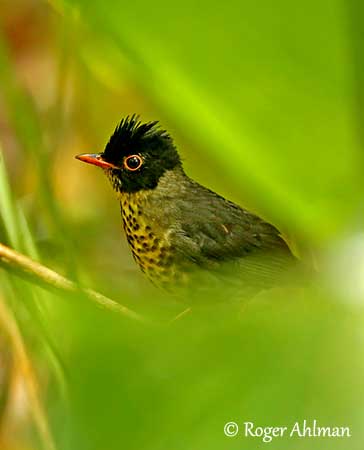
CALLS AND SONGS: SOUNDS BY XENO-CANTO
The Spotted Nightingale-Thrush is most vocal during the breeding season. The song is a series of short, fluty phrases consisting of 2-3 liquid or sometimes guttural notes “clee-oo-leew clee-oo-low” and other variants. This song is sometimes given in flight. The common call is mostly nasal “rreeeee”. This species also produces loud bill-clapping.
BEHAVIOUR IN THE WILD:
The Spotted Nightingale-Thrush feeds primarily on and near the ground, and forages in the undergrowth among the leaf litter like numerous Turdidae.
It feeds on ant and bees (hymenoptera), beetles (coleopteran), various insects (arthropods) and occasionally follows swarms of army ants. It also feeds on some plant matter of genus Saurania and Hedyosmum mexicanum. Fruits and berries are taken too.
The Spotted Nightingale-Thrush can be seen on the ground, often flicking wings and tail and hopping nervously here and there. This bird is usually very active and can be seen alone or in pairs, and occasionally in small mixed groups. It prefers the dense undergrowth and usually remains near the vegetal cover while foraging.
There is no information about the breeding behaviour. They are probably territorial during the breeding season, and the pairs are monogamous. They sing loudly to advertise the territory. Gestures like cocking the tail when landing and flicking and dropping the wings become more pronounced as the breeding period progresses.
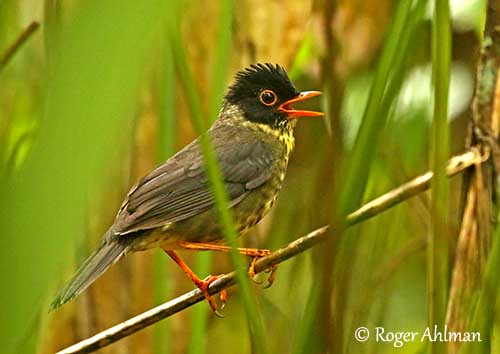
The Spotted Nightingale-Thrush is resident in its range. Occasionally, some birds may perform seasonal altitudinal movements, but rarely.
Like other Turdidae, this species has an undulating flight.
REPRODUCTION OF THIS SPECIES:
The breeding season varies according to the range.
The Spotted Nightingale-Thrush builds a cup-shaped nest with twigs and moss, strengthened with mud. The nest is placed about 1m/1,50 metre above the ground. It is concealed among the dense vegetation in the wet forest.
The female lays 2 bluish-white eggs with greyish markings. The incubation by the female alone lasts about 12-15 days. However, both parents feed the chicks which fledge two weeks after hatching. The young birds remain with their parents for 4 weeks after fledging, and they are still fed by the adults. Then, they stay in the parental territory for 4 months.
The main predators of these birds are the raptors.
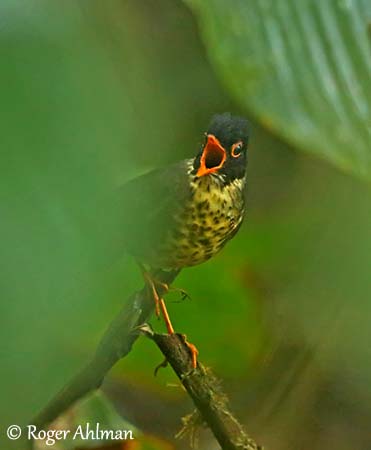
PROTECTION / THREATS / STATUS:
The Spotted Nightingale-Thrush has large range, but it is threatened by habitat loss through deforestation, especially in Mexico, which reduces the suitable breeding areas. In addition, this species appears reluctant to some adaptation to new habitat types.
The global population was estimated in 2008, and placed in the band 50,000/499,999 individuals. This population is suspected to be in decline due to destruction and degradation of the habitat.
But currently, the Spotted Nightingale-Thrush is still evaluated as Least Concern.
